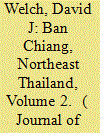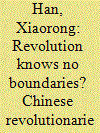|
|
|
Sort Order |
|
|
|
Items / Page
|
|
|
|
|
|
|
| Srl | Item |
| 1 |
ID:
179335


|
|
|
|
|
| Summary/Abstract |
The artworks 1001st Island — The Most Sustainable Island in Archipelago (2015–16) by Tita Salina and Dewa Murka (2016) by Teja Astawa are compared as a means to provide insight into ways artists have been interrogating recent urban discourse in Indonesian contemporary art. This article engages with the critical vocabulary proposed by urban historian Abidin Kusno, which analyses green discourse in the changing Indonesian urban landscapes of the post-Suharto era, and explores how these two artworks reflect Kusno's analysis. Salina's multi-media installation and Astawa's painting address two land reclamation projects in areas that have faced rapid urbanisation: Jakarta and Bali. The artworks evoke questions about tradition, spirituality, environmental sustainability and socioeconomic inequality. The artworks are formally and contextually analysed before being compared and evaluated in relation to Indonesian urban history and discourse. Both artists reflect Kusno's critical analysis of green discourse in Indonesia. Salina's work shares parallels with the tools applied by the government in Jakarta, as her artistic practice similarly requires communities to participate in its creation. Meanwhile, Astawa's work mostly reflects the narrative of green discourse. This conclusion invites further investigation into the Java-centrism of urban discourse and the varying ways in which green discourse may be taking place across the Indonesian archipelago.
|
|
|
|
|
|
|
|
|
|
|
|
|
|
|
|
| 2 |
ID:
179336


|
|
|
|
|
| Summary/Abstract |
These three volumes, along with the forthcoming Volume 2D, the catalogue of metal and metal-related finds, present the results of a thorough, detailed study of the metals recovered during archaeological investigations in 1974 and 1975 at the village of Ban Chiang and three smaller sites in the northern part of northeast Thailand. At a time when little was known of Southeast Asian prehistory, the finding of very elaborately painted earthenware pottery vessels, probably prehistoric, at Ban Chiang stirred the interest not only of archaeologists, but also, unfortunately, from the standpoint of scientific investigation of the past, that of looters, dealers, and collectors of antiquarian art. In order to recover a sample of these vessels in their original depositional context, the Thailand Fine Arts Department and the University of Pennsylvania undertook one of the largest excavations of a prehistoric site carried out in Southeast Asia at the time. What subsequently caused added excitement in the media and the scientific community was the recovery of artefacts of iron that appeared to date to the second millennium BCE and of copper or bronze associated with dates in the fourth millennium BCE, perhaps as early as 3600 BCE, seeming to confirm similar early dates for bronze working from the nearby site of Non Nok Tha. Such early dates suggested the possibility of an independent development of metallurgy in Southeast Asia. Because of the importance of the excavation at Ban Chiang as a milestone in Thai and Southeast Asian archaeology, the site was later placed on the UNESCO World Heritage List.
|
|
|
|
|
|
|
|
|
|
|
|
|
|
|
|
| 3 |
ID:
179330


|
|
|
|
|
| Summary/Abstract |
Southeast Asian Studies (SEAS) in China has experienced significant changes in the past twenty years. China's rising political and economic power has stimulated growing demands for better understanding of the wider world, resulting in the rapid development of area studies in recent years. Although SEAS in China predated the relatively recent notion of ‘area studies’ by at least half a century, the boom in area studies has profoundly transformed the field, most notably by attracting a large number of scholars to conduct policy-relevant research. Not only does the ‘policy turn’ reflect shifts of research paradigms in the field of SEAS, but it is also consistent with some larger trends prevailing in China's higher education sector and rapidly changing society in general. This article shows that SEAS in China has grown even more imbalanced, as indicated by the rapid growth of language programmes, absolute domination of short-term policy research, and further marginalisation of humanistic subjects. To respond, Chinese universities have adopted new approaches to SEAS depending on their distinct disciplinary foundations, language coverage, faculty interests, and local governments’ policy preferences.
|
|
|
|
|
|
|
|
|
|
|
|
|
|
|
|
| 4 |
ID:
179331


|
|
|
|
|
| Summary/Abstract |
This article sets out to demonstrate the Southeast Asian nature of Nanzhao as a Sinitic state similar to Dai Viet. Previous studies have focused on Nanzhao's relations with Tang China, and emphasised the heavy Tang influence on its political organisation. Examining Nanzhao's expansion of governance into the Upper Ayeyarwady and Upper Mekong river regions during the eighth and ninth centuries, I argue that it was a kingdom characterised by a combination of Sinitic-style bureaucracy with indigenous Southeast Asian allegiance ties. I demonstrate how Nanzhao utilised these features to broaden its entire power base by administering conquered peoples and maintaining trade routes in the Upper Ayeyarwady and the Upper Mekong from a network of walled-cities. Though Confucianism exerted limited influence at the local level, the elite invoked Confucian civilising ideology to morally justify their governance of conquered peoples. The authority of the king extended beyond the core area, and his bureaucracy was powerful enough to loosely administer regional areas and to shift subdued peoples to populate strategic points within the kingdom, while governing Mon-Khmer polities at the southern periphery indirectly through their own leaders.
|
|
|
|
|
|
|
|
|
|
|
|
|
|
|
|
| 5 |
ID:
179332


|
|
|
|
|
| Summary/Abstract |
This article examines the collaboration between the law firm of C.W. Baron van Heeckeren from Semarang and the Oei Tiong Ham Concern (OTHC). From the 1880s this Dutch law firm became the centre of a close-knit group of Dutch lawyer-entrepreneurs who through interlocking business directorships developed important sectors of the Javanese economy and the city of Semarang. In doing so Van Heeckeren and his associates teamed up with the Chinese business elite of the port-city. In particular they worked with the foremost Overseas Chinese capitalist, Major Oei Tiong Ham, developing profitable partnerships. The Dutch lawyers acted not only as his legal advisors, but developed his sugar empire as directors-shareholders, held major stakes in his shipping business and coolie trade, and profited from his opium trade. They moreover helped Oei Tiong Ham to acquire real estate and enterprises formerly belonging to powerful Chinese opium farmers and collaborated with him in developing infrastructural and housing projects. This article provides new and revealing details about how the business world of colonial Java worked during the early phase of Dutch economic imperialism and how the Chinese business elite seized the opportunities provided by the Dutch colonial state to advance their business interests.
|
|
|
|
|
|
|
|
|
|
|
|
|
|
|
|
| 6 |
ID:
179334


|
|
|
|
|
| Summary/Abstract |
This article examines the phenomenon of Cambodian intellectual curiosity about China through the social experiences of Phouk Chhay, a prominent leftist activist-critic and Pol Pot's one-time secretary. Amid Phnom Penh's urban radical culture, Phouk transformed from rural student to Communist guerrilla. He associated with Communists, formed pro-China student associations, and through his networks, went on trips that left lasting impressions. This study draws from issues of the Cambodian-Chinese newspaper Mianhua ribao (Sino-Khmer Daily) and several forced confessions to tell a story of becoming that examines community and network in charting the course of ‘China-curiosity’ as intertwined with Phouk's life trajectory.
|
|
|
|
|
|
|
|
|
|
|
|
|
|
|
|
| 7 |
ID:
179333


|
|
|
|
|
| Summary/Abstract |
This article analyses the roles and activities of three groups of Chinese communist revolutionaries in the early phase of the First Indochina War. The author argues that although the Chinese Communist Party (CCP) did not begin to provide substantial aid to North Vietnam until 1950, the involvement of Chinese communists, including members of both the CCP and the Indochinese Communist Party (ICP), in the First Indochina War started at the very moment the war broke out in 1946. Although the early participants were not as prominent as the Chinese political and military advisers who arrived after 1949, their activities deserve to be examined, not only because they were the forerunners of later actors, but also because they had already made concrete contributions to the Vietnamese revolution before the founding of the People's Republic of China and the arrival of large-scale Chinese military and economic aid. Moreover, interactions between early Chinese participants and the Vietnamese revolutionaries established a pattern that would characterise Sino–Vietnamese relations in the subsequent decades.
|
|
|
|
|
|
|
|
|
|
|
|
|
|
|
|
|
|
|
|
|